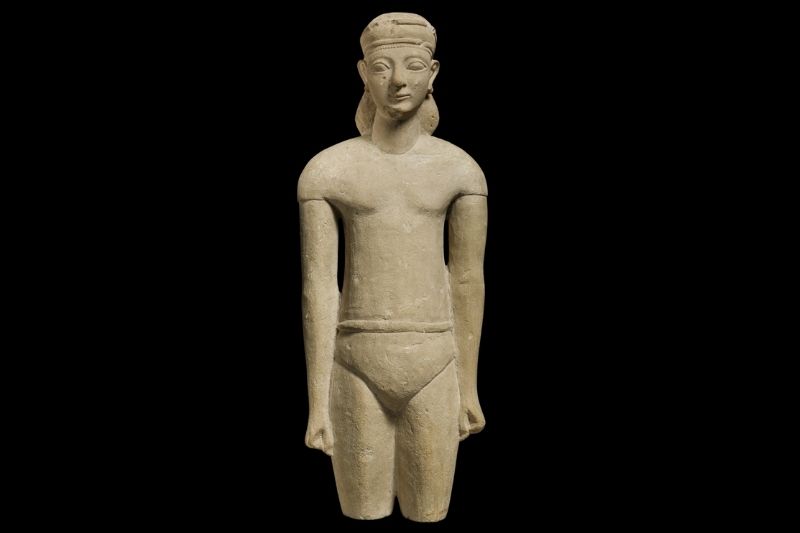The ancient Egyptians used the “schenti”, a type of loincloth similar to a skirt, and the Romans used the “subligaculum”. The medieval world adopted the “braie” and “chauss” before the “crotch” was introduced during the Renaissance. Despite all these changes, one element remained consistent: the concealment of a man’s genital area.
Soon these changes came to fruition and shorts, briefs and boxers began to appear. All in all, the history of underwear is a mix of practicality, change and fashion.

Early forms of underwear
The oldest form of underwear was the peshtemal. Used by both men and women in prehistoric times, peshtemals were made of strips of fabric that passed between the legs and were tied around the waist.
The ancient Egyptians designed triangular pieces of fabric with strings at the ends. Modern observers might associate this look with a skirt, but these “schenti” varied in length. Before they were used by members of the lower social classes, schenti were worn by pharaohs and nobles. Tutankhamun was buried with 145 “schenti” along with a large collection of loincloths that he would take with him to the underworld.
Nudity was much more acceptable in the ancient Greek world, but even there one could wear underwear similar to the Egyptian underwear called perisoma.

The ancient Romans had their own underwear for sports under a tunic, toga or robe: The Roman “subligaculum”, worn in the mid-2nd century AD and adapted from the Etruscans, looked like a loincloth or more like shorts.
Similarly, Celts and Germanic tribes in the Middle Ages wore baggy shorts called “braie”. It is not clear whether (or how often) both men and women wore “braies”, but it is known that men used a belt or string to fasten their “braies”. Some also wore “chausses” (a type of tights) and by the 15th century the two pieces had more or less become one.

These undergarments eventually gave way to more elaborate crotches, designed not only to cover but also to protect a man’s genital area. The crotch was made of stiffer materials, decorated, padded and made progressively larger to imply one’s masculinity.
Boxers, briefs and other innovations in underwear
However, the need for cloth garments to be worn under tunics and similar items continued. In the early 19th century, tight trousers emerged as a practical part of all kinds of clothing for men and women, as they absorbed dirt and sweat, keeping outerwear clean.
This period also saw the emergence of one-piece underwear, the predecessors of long-legged underwear and overalls, to meet the needs of both men and women. This allowed men to wear blouses and shirts on the outside, while women could get away with wearing corsets, stockings and garters. As industrialization meant more men and women working in factories, this innovation was very useful.

When bicycles became widely used, sports underwear provided additional support for riders pedaling on bumpy streets. The first sports underwear was introduced in 1874. Thanks to Jacob Golomb and his swimsuits with elastic waistbands and boxing shorts (an innovation that led to the emergence of boxers as underwear), underwear and sporting goods became more closely related in the early 20th century.
Boxers weren’t that popular at first, but that wasn’t the case for briefs, which were developed around the same time. In 1928, Arthur Kneibler was hired by the Cooper Underwear Company, where as a “clothing engineer” he designed briefs fashioned from athletic underwear. Kneibler’s jockey shorts were a hit as soon as they hit store shelves in 1935.
Familiar brand names were at the center of 19th and 20th century underwear innovation. While Hanes relied on the one-piece underwear market, Golcomb’s efforts created the sportswear company Everlast. Cooper changed its name to “Jockey” thanks to Kneibler’s guidance. Fruit of the Loom’s aptly named logo could also be found on underwear at the turn of the new century.
Underwear is becoming mainstream
Underwear became a fashion item in the 1950s and 1960s, transitioning from traditional white to a variety of colors and patterns, and the development of rayon and synthetic fabrics made new styles possible for men and women.
As a result, underwear advertisements became more prominent and were soon accompanied by bikini briefs and nylon thongs in marketing campaigns.

In the 1980s and 1990s, the world was debating this critical question: Boxers or briefs? Boxers became increasingly popular after World War II, with men serving in the military adapting to standard boxer shorts. But as the century progressed, people began to question whether there were health benefits to wearing them, and a trend was born asking famous men, including US President Bill Clinton, to share which one they wore.
But soon a new option emerged as a mix of the two styles: tight boxer shorts.
Calvin Klein designer John Varvatos is credited with inventing tight boxer shorts in the early 1990s, but he may not have been the first to come up with the idea. They became popular after a 1992 ad campaign featuring rapper-turned-actor Mark Wahlberg wearing nothing but white Calvin Klein boxer shorts. The racy ads, shot by photographer Herb Ritz, sparked controversy and in the process made Calvin Klein a household name in underwear.
Since then, innovations in underwear have dwindled, but when a new product is launched, it’s likely to be in the spotlight.



